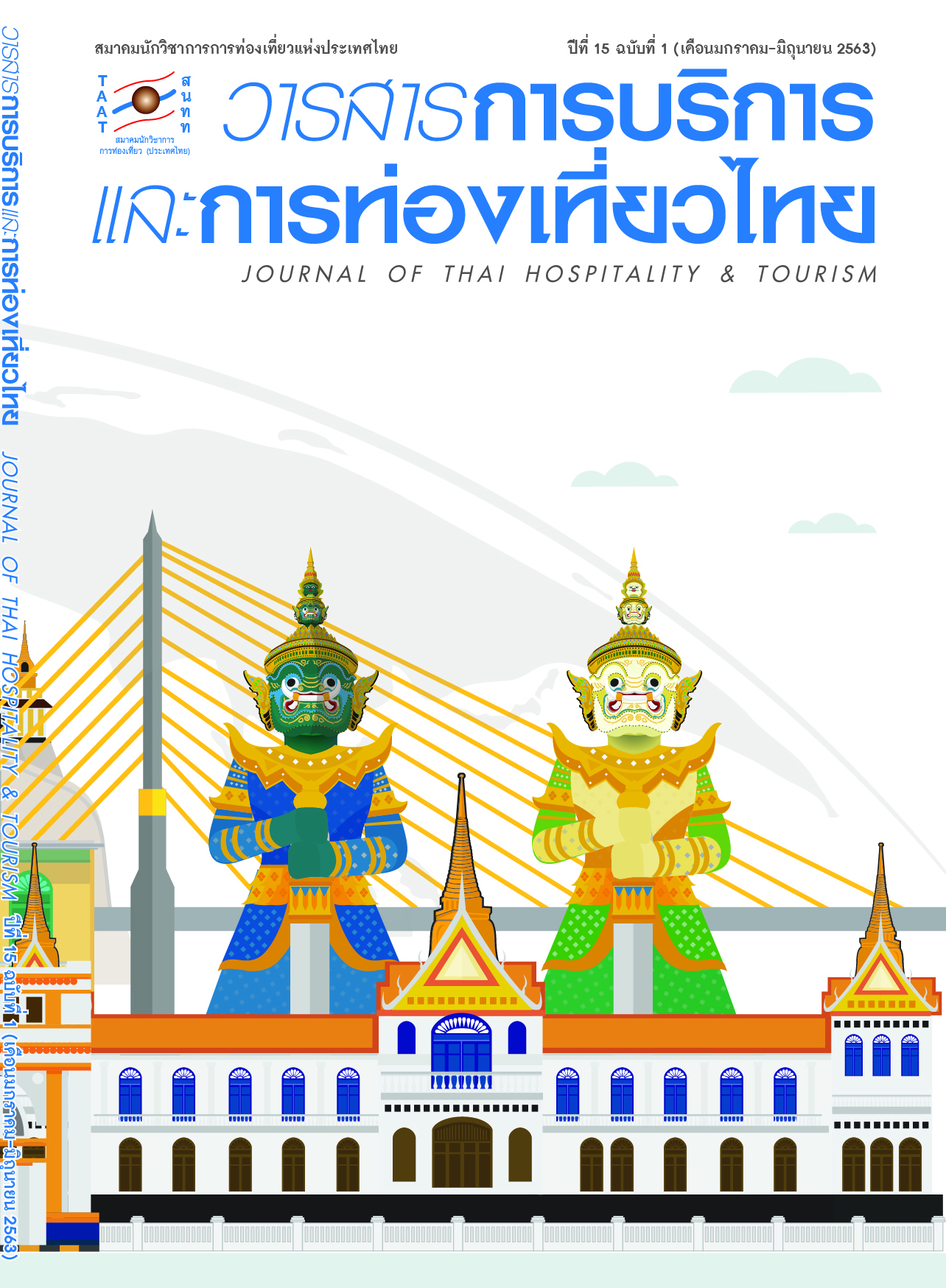The Study of Key Success Factors of Wellness Tourism Service Business Case of Spa Business
Main Article Content
Abstract
This research endeavor aims at studying key success factors of the wellness tourism service business, particularly spa business. The purpose of this quantitative research study is to study important success factors of wellness tourism specifically spa businesses and their relation to customer service and financial status. The research method used was the collection of data from 109 spa business owners, with the use of questionnaires. The principal component analysis of 37 components, the result showed success factors in the intra-business management factor, innovation-oriented factor, investment management factor, uniqueness creation factor, and marketing communication factor. After considering the Multiple Linear Regression Analysis, the result of the study of success factors and customer service revealed that intra-business management factor, innovation-oriented factor, and marketing communication factor had a high correlation with customer service, equivalent to 0.757 and the regression coefficient of success factors whose customer service result can be predicted was as follows:
Y = 0.981+ 0.378 (intra-business management factor) + 0.172 (innovation-oriented factor) + 0.193 (marketing communication factor)
The result of the study of success factors and financial status showed that there were positive correlations among all of the 5 success factors and the order by magnitude of Spearman’s Rank Correlation Coefficients was as follows: Intra-business management factor (0.444) Marketing communication factor (0.438) Investment management factor (0.340) Innovation-oriented factor (0.318) Uniqueness creation factor (0.278), respectively
Article Details
References
Akarapong Untong. (2017). The Factor Structure of International Tourist Satisfaction to the Spa Service Quality in Thailand. Journal of Thai Hospitality and Tourism, 12(2), 3–16.
Arrun Boonchai & Jinna Tansaraviput. (2003). Health Tourism: New Selling Point of Thai Tourism. Economic and Social Journal: NESDC, 40(5), 22–27.
Department of Business Development. (2013). Report of the Study on the Strategic Plan for Thai Business Development for ASEAN. Nonthaburi: Department of Business Development.
Department of Health Service Support, Health Service Support Department. (2015). Report Number of Health Care Service (Establishments by Area). Annual Report, Department of Health Services Support. Retrieved from https://mrd.hss.moph.go.th/display_document.jsp?id=D00000001604.
Ellis, S. (2013). ITB Experts Forum Wellness: The Global Wellness Tourism Economy 2013. Retrieved from https://www.itb-kongress.de/media/itbk/Archiv_2014/ITB_Experts_Forum_Wellness_2/The_Global_Wellness_Tourism_Economy_2013.pdf
Global Spa Summit. (2011). Wellness Tourism and Medical Tourism: Where Do Spas Fit?. Retrieved from https://www.globalspaandwellnesssummit.org/images/stories/pdf/spas_wellness_medical_tourism_report_final.pdf
Grid Rangsungnoen. (2011). Statistical Analysis of Computer Data for Research. Bangkok: Se–ed Public Company Limited.
Institute for Small and Medium Enterprises Development: ISMED. (2013). Final Report: Small and Medium Enterprise Development Strategy and Action Plan. Bangkok: Institute for Small and Medium Enterprises Development.
Kanlaya Vanichbuncha. (2014). Structural Equation Analysis (SEM) with AMOS. Bangkok: Sam Lada.
Kliatchko, J. (2008). Revisiting The IMC Construct: A Revised Definition and Four Pillars. International Journal of Advertising, 27(1), 133–160.
Krejcie, R. V. & Morgan, D. W. (1970). Determining Sample Size For Research Activities. Educational and Psychological Measurement, 30, 607–610.
Mingsarn Kaosa–ard et al. (2012). Promoting the Potential of Hi–Value Tourism Industry and Hi–Value Destination. Bangkok: National Research Council of Thailand.
Mongkol Wongwuttisak. (2007). Factors Related to Success in Health Spa Businesses in Bangkok Metropolitan Area. Master’s Thesis, Mahidol University.
Papaporn Chaihanchanchai & Saravudh Anantachart. (2012). Integrated Marketing Communications: Reviewing Meaning, Principles, and Issues Related to Implementation. Journal of Public Relations and Advertising, 5(2), 131–161.
Parasee Anek. (2012). The Marketing Component Influence to the Value Perception in Using Spa Service of Foreigner Tourist in Chiangmai Province. Journal of Management Sciences, 28(2), 63–72.
Phahol Sakkatat, Surachai Kungwon & Neunghathai Tuntasantisom. (2013). Strengths of Community Spa and Thai Traditional Massage Business in Chiang Mai. Journal of Social Sciences and Liberal Arts, 2(1), 54–59.
Rungarun Khasasin, Rapeepan Piriyakul & Napaporn Khantanapha. (2016). Firm Performance and Entrepreneurial Competency, Competitive Scope and Firm Capability. Kasem Bundit Journal, 17(1), 1–21.
Sirichai Pongvichai. (2011). Statistical Analysis of Computer Data for Research. Bangkok: Chulalongkorn University Press.
Somruthai Namtip & Orapan Khongmalai. (2015). The Impact of Service Innovation to Competitive Advantage in Higher Education. SDU Research Journal, 11(2), 43–59.
Supamas Angsuchoti, Somtawin Wijitwanna & Ratchaneekool Pinyopanuwat. (2011). Statistical Analysis for Social Science Research and Behavioral Sciences: Techniques for Using LISREL Programs. Bangkok: Charoendimankong.
Thai Airfreight Forwarders Association Profile. (2015). Thai Spa Business. Retrieved from https://ditp.go.th/contents_attach/143532/143532.pdf
Wong, K. M., Velasamy, P. & Arshad, T. N. T. (2014). Medical Tourism Destination SWOT Analysis: A Case Study of Malaysia, Thailand, Singapore and India. Retrieved from https://www.shs–conferences.org/articles/shsconf/pdf/2014/09/shsconf_4ictr2014_01037.pdf
Wutthigrai Ngamsirijit et al. (2013). Creative Service Health Tourism. Creative Economy: Thailand’s Context Revealed. Bangkok: Savika Press, pp.61–66.
Yuth Kaiyawan. (2014). Multivariate Statistical Analysis for Research. Bangkok: Chulalongkorn University Press.


